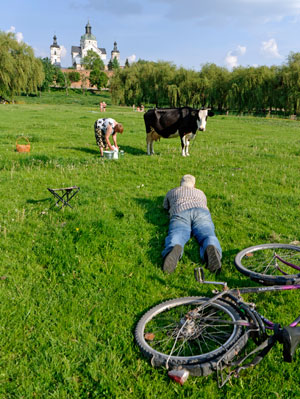Milk rivers” recede
“Now is the high time for the National Security and Defense Council to get involved with the industry’s problems
“Ukraine is still unable to stop its milk output falling,” director of the animal products markets department at the Ministry of Agrarian Policy and Food of Ukraine Andrii Hetia admitted recently. According to him, the country’s milk output for the year to date was three percent less than in the corresponding period last year, and national milk yield keeps falling year after year. Cattle numbers follow a similar trajectory, being reduced on industrial farms and in the so-called household sector alike. The industry experts note that Ukraine’s milk output has fallen by almost a third in the last decade.
Surprisingly, the director does not dramatize the situation despite clear deficit of natural milk in this country. Scientific dietetics prescribes 380 liters of milk per person per year, but Ukraine produces only 211 liters per person annually. Hetia entertains no hope of output increase, as he sees no opportunities for growth in demand for this product, despite it being the most important one for humans in general and children in particular!
According to Hetia, the “milk rivers” receded fastest in the industrial animal husbandry sector. Ukraine’s industrial farms produced 18 million tons of milk in 1991, but now their output has fallen to just 2 million tons. He says: “The ministry aims to revive industrial production of milk in particular,” and officials even see some positive signs there. The head of the department continues: “Lately, these enterprises are reducing output slower than the dairy sector in general. Industrial farms even exceeded the last year’s corresponding period’s output levels in the last two months.” He adds that Kharkiv region was especially successful, with cattle numbers on the rise on industrial farms and in households alike. Overall, the milk cow numbers are on the rise in nine of Ukrainian regions. Is their effort the reason for Ukraine’s presence among the world’s top 10 exporters of dairy products? Hetia hopes that cattle numbers will stop falling by this year’s end. He believes that the ministry’s policies contribute to the improvements, in spite of expressing his confidence that the government subsidy of 30-35 kopecks per liter of milk was harmful rather than helpful for the dairy industry.
President of the Dairy Association of Ukraine Andrii Dykun disagrees. He believes that the subsidy encouraged exactly those who were willing to work. “It is easy to calculate gains for those who got 8,000 liters per year per cow, compared with those who produced only 4,000 liters,” the expert says and continues: “This was an effective and real incentive.” At the same time, Dykun notes that developing the dairy industry requires large investments, which are absent, as the business community is still waiting despite the fact that milk production is now quite profitable. According to the association’s president, investors need firm guarantees that the land that is needed for livestock (1,000 hectares per 1,000 heads) would not be taken away by anybody. “This is really difficult issue nowadays,” the expert states and notes that it is more important than any government monetary subsidies.
Director of the Biona group of companies Artur Karganian employs different approach to the development of dairy farming. He speaks of several serious violations of best practice in industrial farming, which affect the reduction of the herd. Nowadays, cows are prevented from licking newly born calves and forming in that way their intestinal microflora, and calves do not receive colostrum in the first eight days of their lives. The expert notes: “As a result, we get serious problems: about 40 percent of calves die during the first week after birth because they lack natural immunity.” He continues: “After giving birth, the cow is hastily treated with large doses of antibiotics, causing severe allergic reactions,” but “forgets” to add that similar reactions may occur also in children who consume dairy products.
The experts’ almost exclusive attention to industrial dairy farming was a little surprising, as it is well-known that 80 percent of milk in this country is produced in households. So, is it drinkable at all, and what the ministry intends to do to improve this sector, too? The director’s answer to The Day’s question showed that the “headquarters” of the dairy industry was very much familiar with all the problems that exist in households and family farms, but did not know how to solve them because of their complexity. Family farmers alone need almost 200 million hryvnias to buy cows abroad. It would add another 5,000 heads to the 37,000 cows they already have. “You see, it requires a large outlay for no substantial addition to the herd, it would seem like we did nothing. As for households, it is the most contentious question, because it lacks simple answers,” Hetia says sadly. “Any offer from our side is met with harsh criticism.”






